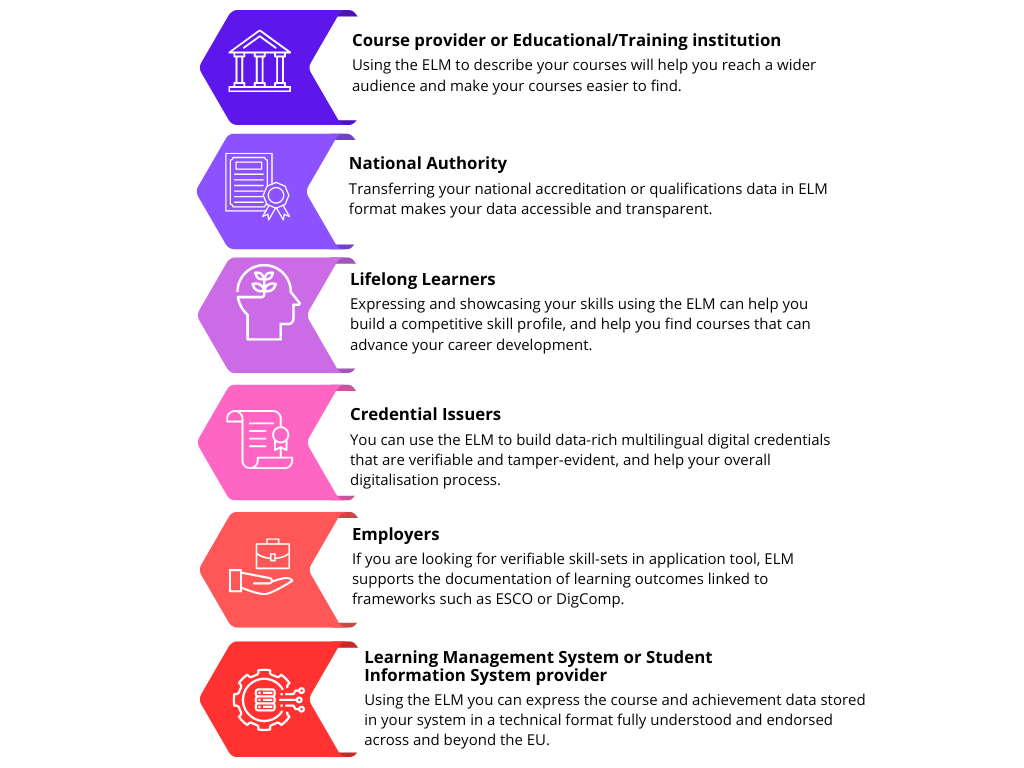Launch of the European Learning Model
In the spirit of the European Year of Skills, the European Learning Model supports the process of matching people’s aspirations and skillsets with labour market needs and opportunities. By providing tools to support the recognition of qualifications and the validation of skills, the ELM promotes a mindset of up/reskilling and lifelong learning.
The European Commission is launching the European Learning Model v.3 (ELM v.3). This first multilingual data model for learning is an exciting new development in the field of knowledge and skills data exchange, opening new possibilities for interoperability and credential exchange.
As part of the tasks set forward in the Europass Decision, the ELM will help further the goals of the European Skills Agenda, the European Education Area and the Digital Education Action Plan. Up until now, almost every sector, country, level of education and training has had its unique way to provide data related to learning. This fragmentation has hindered possibilities for common systems and exchange of information. By establishing a single vocabulary for learning in Europe, ELM aims to help the recognition of and trust in qualifications and digital credentials across Europe, supporting the fight against fraud. Aligning with the ELM allows for the comparability, transparency and portability of all data related to learning. By providing a tool to ease recognition processes, the ELM contributes to the wider goals of the European Commission to promote labour and learning mobility in Europe. The data richness of the ELM supports the visibility of skills and contributes to a ‘Skills first’ approach.
The ELM has been built using the starting points provided in the Annex VI of the European Qualifications Framework Council Recommendation on “Elements of data fields for the electronic publication of information on qualifications with an EQF level” as well as Annex I “European standard elements to describe a micro-credential” of the Council Recommendation on a European Approach to Micro-credentials.
With over 480 properties, the ELM allows for the capture of all learning related data, including formal, non-formal and informal learning and validation. It caters for the needs of general education, Vocational Education and Training, higher education, adult learning, and labour market trainings. This allows for the creation and portability of rich data, for instance for European Digital Credentials for Learning. Its uses are not limited to a single sector and addresses actors in Employment, Skills, Education and Training alike.
Linking to existing initiatives, the ELM can streamline the description of learning within other EU level activities (such as the European Blockchain Services Infrastructure, Micro-credentials, Erasmus Without Paper and the European Student Card Initiative). A single data model provides the basis for interoperability between these initiatives and beyond and allows for the extension and customisation of its use to a national context as has been shown in ongoing national implementations. It is also an important step towards the construction of the Common European Skills Data Space.
By providing a unified way to refer to and describe all things related to learning, the ELM allows for the understanding of concepts in the same way across countries and organisations. This, in turn, eases the data interchange process across Europe as any organisation or entity working with learning can make use of the same concepts, making the data understandable even across languages. For instance, when providing information about a learning opportunity (such as a university degree programme or a short online course), this information can be presented in a way that is understood across all EU Member States. This way, a potential employer in another country can also discern exactly what a person has learned and achieved through a particular opportunity.
For further information about the ELM, we invite you to consult our Introduction to the ELM.

Benefits of ELM v3
- One stable, long-term support version of the model addressing all levels and forms of learning.
- The model is mapped to, and interoperable with, other models, including ELMO and the European Blockchain Services Infrastructure Diploma Use Case. It is also linked to existing frameworks and classifications (e.g. EQF, ESCO, ISCED-F).
- Built on open standards, in particular the W3C Verifiable Credential data model.
- Available in all 31 languages of Europass.
- Supports data exchange and credential recognition.
- Aligns with policy developments, EU initiatives and services, in particular with the Council Recommendation on Micro-Credentials.
- Allows learning providers to use the European Commission’s infrastructure to build and issue data-rich digital credentials completely free of charge.
- Allows for data on learning opportunities, qualifications, accreditation and credentials to be visualised, and interpreted in 31 languages, on the Europass portal.
You can access the ELM on Github and on the Commission’s Publication Office. For any questions regarding the ELM or its uses, you can get in touch with us at EMPL-ELM-SUPPORT@ec.europa.eu.
Watch the recording of our Launch Webinar of the 11th of May 2023.

 Facebook
Facebook
 Twitter
Twitter
 Linkedin
Linkedin